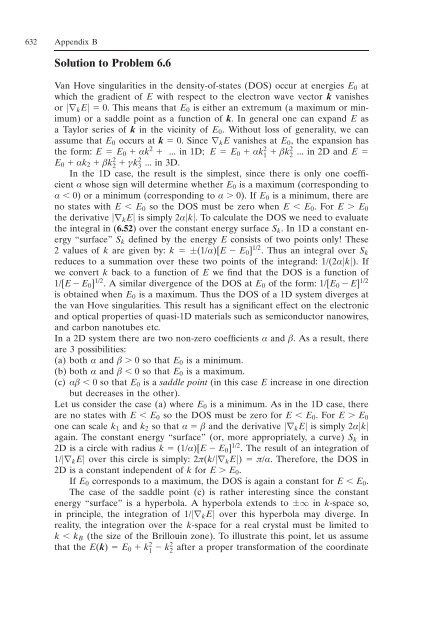10. Appendix
You also want an ePaper? Increase the reach of your titles
YUMPU automatically turns print PDFs into web optimized ePapers that Google loves.
632 <strong>Appendix</strong> B<br />
Solution to Problem 6.6<br />
Van Hove singularities in the density-of-states (DOS) occur at energies E0 at<br />
which the gradient of E with respect to the electron wave vector k vanishes<br />
or |∇kE| 0. This means that E0 is either an extremum (a maximum or minimum)<br />
or a saddle point as a function of k. In general one can expand E as<br />
a Taylor series of k in the vicinity of E0. Without loss of generality, we can<br />
assume that E0 occurs at k 0. Since ∇kE vanishes at E0, the expansion has<br />
the form: E E0 ·k2 ... in 1D; E E0 ·k2 1 ‚k2 2 ... in 2D and E <br />
E0 ·k2 ‚k2 2 Ák2 3 ... in 3D.<br />
In the 1D case, the result is the simplest, since there is only one coefficient<br />
· whose sign will determine whether E0 is a maximum (corresponding to<br />
· 0) or a minimum (corresponding to · 0). If E0 is a minimum, there are<br />
no states with E E0 so the DOS must be zero when E E0. ForE E0<br />
the derivative |∇kE| is simply 2·|k|. To calculate the DOS we need to evaluate<br />
the integral in (6.52) over the constant energy surface Sk. In 1D a constant energy<br />
“surface” Sk defined by the energy E consists of two points only! These<br />
2 values of k are given by: k ±(1/·)[E E0] 1/2 . Thus an integral over Sk<br />
reduces to a summation over these two points of the integrand: 1/(2·|k|). If<br />
we convert k back to a function of E we find that the DOS is a function of<br />
1/[E E0] 1/2 . A similar divergence of the DOS at E0 of the form: 1/[E0 E] 1/2<br />
is obtained when E0 is a maximum. Thus the DOS of a 1D system diverges at<br />
the van Hove singularities. This result has a significant effect on the electronic<br />
and optical properties of quasi-1D materials such as semiconductor nanowires,<br />
and carbon nanotubes etc.<br />
In a 2D system there are two non-zero coefficients · and ‚. As a result, there<br />
are 3 possibilities:<br />
(a) both · and ‚ 0 so that E0 is a minimum.<br />
(b) both · and ‚ 0 so that E0 is a maximum.<br />
(c) ·‚ 0 so that E0 is a saddle point (in this case E increase in one direction<br />
but decreases in the other).<br />
Let us consider the case (a) where E0 is a minimum. As in the 1D case, there<br />
are no states with E E0 so the DOS must be zero for E E0. ForEE0 one can scale k1 and k2 so that · ‚ and the derivative |∇kE| is simply 2·|k|<br />
again. The constant energy “surface” (or, more appropriately, a curve) Sk in<br />
2D is a circle with radius k (1/·)[E E0] 1/2 . The result of an integration of<br />
1/|∇kE| over this circle is simply: 2apple(k/|∇kE|) apple/·. Therefore, the DOS in<br />
2D is a constant independent of k for E E0.<br />
If E0 corresponds to a maximum, the DOS is again a constant for E E0.<br />
The case of the saddle point (c) is rather interesting since the constant<br />
energy “surface” is a hyperbola. A hyperbola extends to ±∞ in k-space so,<br />
in principle, the integration of 1/|∇kE| over this hyperbola may diverge. In<br />
reality, the integration over the k-space for a real crystal must be limited to<br />
k kB (the size of the Brillouin zone). To illustrate this point, let us assume<br />
that the E(k) E0 k2 1 k2 2 after a proper transformation of the coordinate










